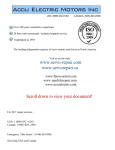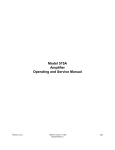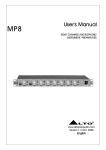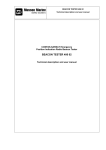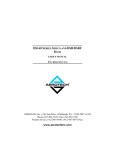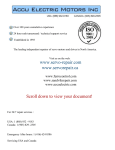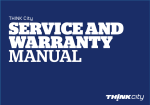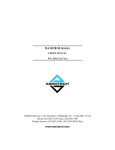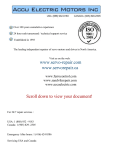Download www.servo-repair.com www.servorepair.ca Scroll down to view your
Transcript
Over 100 years cumulative experience 24 hour rush turnaround / technical support service Established in 1993 The leading independent repairer of servo motors and drives in North America. Visit us on the web: www.servo-repair.com www.servorepair.ca www.ferrocontrol.com www.sandvikrepair.com www.accuelectric.com Scroll down to view your document! For 24/7 repair services : USA: 1 (888) 932 - 9183 Canada: 1 (905) 829 -2505 Emergency After hours: 1 (416) 624 0386 Servicing USA and Canada 6020HRJ/8030J SWITCHING SERVO CONTROLLER USER’S MANUAL P/N: EDA107 (V1.1) AEROTECH, Inc. • 101 Zeta Drive • Pittsburgh, PA. 15238-2897 • USA Phone (412) 963-7470 • Fax (412) 963-7459 Product Service: (412) 967-6440; (412) 967-6870 (Fax) www.aerotechinc.com If you should have any questions about the 6020HRJ/8030J Switching Servo Controller (6020J/8030J) or comments regarding the documentation, please refer to Aerotech online at: http://www.aerotechinc.com. For your convenience, a product registration form is available at our web site. Our web site is continually updated with new product information, free downloadable software, and special pricing on selected products. 6020HRJ/8030J is a product of Aerotech, Inc. The 6020HRJ/8030J Switching Servo Controller Manual Revision History: Rev 1.0 Rev 1.1 May, 1987 October 26, 2000 6020HRJ/8030J User’s Manual Table of Contents TABLE OF CONTENTS CHAPTER 1: 1.1. INTRODUCTION ............................................................................ 1-1 Description ......................................................................................... 1-1 CHAPTER 2: 2.1. 2.2. 2.3. SPECIFICATIONS .......................................................................... 2-1 Maximum Ratings .............................................................................. 2-1 Electrical Characteristics .................................................................... 2-1 Mechanical Characteristics................................................................. 2-2 CHAPTER 3: 3.1. 3.2. 3.3. INSTALLATION AND OPERATION ........................................... 3-1 Set-Up (Single Amplifier) .................................................................. 3-1 Selecting 6020HRJ or 8030J Operation ............................................. 3-2 Input/Output Connections................................................................... 3-2 3.3.1. AC Inputs (TB1-9, 10 TB2-13, 18, 19)................................ 3-2 3.3.2. Motor Connections (TB2-16, 17)......................................... 3-2 3.3.3. Supplies for External Use (TB2-11, 12, 14, 15, TB14, 6, TB2-13 Common) ........................................................ 3-2 3.3.4. Pre-Amplifier Inputs (TB-1, 2, 3, 5, TB1-4 Common) ........ 3-2 3.3.5. Directional Current Limits (TB1-6, 7, and 8)....................... 3-2 Adjustments........................................................................................ 3-3 3.4.1. Current Limit (R24) ............................................................. 3-3 3.4.2. Gain and Scale Factor Adjustments (R6, R9, R12, and R22)............................................................................... 3-3 3.4.3. Balance Adjustment (R16) ................................................... 3-3 3.4.4. Overcurrent Trip Adjustment (R100)................................... 3-3 Procedure for Checking and Optimizing Performance ....................... 3-4 3.4. 3.5. CHAPTER 4: 4.1. 4.2. 4.3. MAINTENANCE AND REPAIR.................................................... 4-1 Maintenance ....................................................................................... 4-1 Fuse Replacement............................................................................... 4-1 Troubleshooting.................................................................................. 4-2 APPENDIX A: WARRANTY AND FIELD SERVICE POLICY ........................... A-1 INDEX ∇ ∇ ∇ Version 1.1 Aerotech, Inc. iii Table of Contents iv 6020HRJ/8030J User’s Manual Aerotech, Inc. Version 1.1 6020HRJ/8030J User’s Manual List of Figures and Tables LIST OF FIGURES Figure 3-1. Controller Diagram ................................................................................. 3-1 LIST OF TABLES Table 2-1. Table 2-2. Table 2-3. 6020HRJ/8030J Amplifier Ratings and Characteristics ..................... 2-1 6020HRJ/8030J Electrical Characteristics ......................................... 2-1 6020HRJ/8030J Mechanical Characteristics ...................................... 2-2 Table 4-1. Troubleshooting.................................................................................. 4-2 ∇ ∇ ∇ Version 1.1 Aerotech, Inc. v List of Figures and Tables vi 6020HRJ/8030J User’s Manual Aerotech, Inc. Version 1.1 6020HRJ/8030J User’s Manual Introduction CHAPTER 1: INTRODUCTION In This Section: • Description ......................................................... 1-1 1.1. Description The 6020HRJ/8030J is a single amplifier designed to replace the original 6020HR/8030 amplifier. Many features were added to the design without sacrificing compatibility with current applications. The suffix “J” was added to the model number to indicate the JAN quality level of components used in the power stage. The JAN (Joint ARMY/NAVY) quality level is imposed on qualified semiconductor manufacturers by the U.S. military. Military handbook 217-C (Reliability Prediction of Electronic Equipment) defines JAN components to have a base failure rate five times less than commercial hermetic devices, and ten times less than plastic devices. Experience has shown that most power amplifier failures occur in the power stage. Since the 6020HRJ is operated under reduced stress and fatigue conditions, higher reliability can be expected. The following protection circuits were added to the amplifier. 1. 2. 3. 4. Short circuit protection (output terminal to output terminal or output terminal to ground). Bus overvoltage Bus undervoltage Low level control undervoltage All but #1 are reset automatically when the condition(s) return to normal. The rectifier and filter are integral to the 6020HRJ/8030J, like the original 6020HR. ∇ ∇ ∇ Version 1.1 Aerotech, Inc. 1-1 Introduction 1-2 6020HRJ/8030J User’s Manual Aerotech, Inc. Version 1.1 6020HRJ/8030J User’s Manual CHAPTER 2: Specifications SPECIFICATIONS In This Section: • Maximum Ratings .................................................... 2-1 • Electrical Characteristics.......................................... 2-1 • Mechanical Characteristics ...................................... 2-2 2.1. Maximum Ratings Table 2-1. 6020HRJ/8030J Amplifier Ratings and Characteristics Specifications Peak Output Current Pulse Output Current Continuous Output Current Input Voltage Operating Temperature Storage Temperature 2.2. Units Amps Amps Amps 6020HRJ 8030J ±24 ±33 ±20 ±30 ±10 ±15 80 VAC C.T. ±10% 110 VAC C.T. ±10% 0 to 50 -30 to 85 °C °C Electrical Characteristics Table 2-2. 6020HRJ/8030J Electrical Characteristics Specifications Voltage Gain Offset Drift Gain Current Limit Bandwidth Power Peak Output: Continuous Switching Frequency Form Factor Ripple Current (amps) Regenerative Energy Torque Limits Shutdown Minimum Inductance Input Voltage Power Frequency Supply External ±15VDC Version 1.1 6020HRJ 8030J Pre-Amplifier 100db (open loop) Adjustable to 0 10mV/0c Power Amplifier 2 a/v 3 a/v 4 to 20 amps 6 to 30 amps DC to 1kHz 1000 watts 1500 watts 440 watts 900 watts 5 kHz 3 kHz ( ) ( ) 1 + 3.86 LIo 1 + 1.73 LIo 2 Ip/p = 6/L (mH) Ip/p = 13.3/L (mH) 40 joules 20 joules (TB1-6 to 7 or 7 to 8) Limits to 3 amps (TB1-8 to 6) Limits to 1 amps .75 mH 2.2 mH 80 VAC C.T. 110 VAC C.T. 50/60 Hz 30 mA (max) Aerotech, Inc. 2-1 Specifications 6020HRJ/8030J User’s Manual 2.3. Mechanical Characteristics Table 2-3. 6020HRJ/8030J Mechanical Characteristics Specifications Weight Dimensions Mounting Dimensions Mounting Screws 6020HRJ/8030J 9 lbs 6.7” W x 7.5” L x 6.5” H 5 ½” x 3 5/8” ¼ - 20, 3.8” max depth into controller base plate ∇ ∇ ∇ 2-2 Aerotech, Inc. Version 1.1 6020HRJ/8030J User’s Manual CHAPTER 3: Installation and Operation INSTALLATION AND OPERATION In This Section: • Set-Up (Single Amplifier) ................................................ 3-1 • Selecting 6020HRJ or 8030J Operation........................... 3-2 • Input/Output Connections ................................................ 3-2 • Adjustments ..................................................................... 3-3 • Procedure for Checking and Optimizing Performance..... 3-4 3.1. Set-Up (Single Amplifier) Figure 3-1. Version 1.1 Controller Diagram Aerotech, Inc. 3-1 Installation and Operation 3.2. 6020HRJ/8030J User’s Manual Selecting 6020HRJ or 8030J Operation When ALL FOUR jumpers (J1-J4) are connected, the amplifier must operate as a 6020HRJ. When ALL FOUR jumpers are disconnected, the amplifier must operate as an 8030J amplifier. 3.3. 3.3.1. Input/Output Connections AC Inputs (TB1-9, 10 TB2-13, 18, 19) 115VAC, 50/60 Hz, 50 VA are required for the cooling fan. The connections are made at TB1-9 and 10. Always make sure that the fan is operational before operating the amplifier. The AC input for the power amplifier is made at terminals TB2-18 and 19 with TB2-13 connected to the center tap of the source. The following 50/60 Hz voltages should be used (refer to Figure 3-1). For 6020HRJ operation, use 80 VAC center tapped (C.T.) ±10%. For 8030J operation, use 110 VAC (C.T.) ±10%. Use only terminal TB2-13 for the center tap connection. 3.3.2. Motor Connections (TB2-16, 17) The motor is connected between terminals TB2-16 and 17. Make sure the correct motor is being applied to the amplifier. Check for shorts between motor leads and ground and between motor leads before connecting the motor to the amplifier. A choke may have to be inserted if motor inductance is too small. Total inductance must be greater than .75 mH for 6020HRJ and 2.2 mH for 8030J operation. 3.3.3. Supplies for External Use (TB2-11, 12, 14, 15, TB1-4, 6, TB213 Common) Regulated +15 VDC, 30 mA DC maximum at terminal TB2-12 and –15VDC, 30 mA DC maximum at terminal TB2-11 are available with respect to commons TB1-4, 6, and TB213. Unregulated bus voltage (60 VDC nominal 6020HRJ, 80 VDC nominal for 8030J) is available at TB2-14 and TB2-15. The current drawn from this supply + load current should not exceed the continuous current capability of the unit. The common for this supply must be TB2-13. 3.3.4. Pre-Amplifier Inputs (TB-1, 2, 3, 5, TB1-4 Common) Four inputs are available for input and feedback signals. Inputs 1, 2, and 3 (TB1-1, 2, and 3 respectively) sum to the inverting input of the pre-amplifier. TB1-5 provides a noninverting signal to the pre-amplifier. In addition, TB1-1 and TB1-5 provide a differential input for attenuating common mode from remote signal sources. All input signal commons should be connected to TB1-4 or 6. 3.3.5. Directional Current Limits (TB1-6, 7, and 8) TB1-6, 7, and 8 are available to inhibit current of a specific polarity for limited travel loads. Connecting TB1-6 to TB1-7 limits current between output terminals TB2-16 and TB2-17 at 3 amps or less without inhibiting current between TB2-17 and 16. Likewise, connecting TB1-7 to TB1-8 limits current between TB2-17 and TB2-16 at 3 amps or less without inhibiting current between TB2-16 and TB2-17. Connecting TB1-6 to TB1-8 limits current in both directions at 1 amp or less. 3-2 Aerotech, Inc. Version 1.1 6020HRJ/8030J User’s Manual 3.4. 3.4.1. Installation and Operation Adjustments Current Limit (R24) The maximum value of motor current can be set by adjusting R24 (CW rotation decreases maximum current). The current monitor, TB2-20 (5A/volt) and common may be used to set the desired level. To set, monitor TB2-20 with an oscilloscope (TB1-4 or 6 common) and command the motor to step or reverse speed. Adjust R24 to obtain the desired peak current. 3.4.2. Gain and Scale Factor Adjustments (R6, R9, R12, and R22) Scale factor adjustments are R6, R9, and R12 for inputs 1, 2, and 3 respectively. The GAIN adjustment is R22. Connect the tach to input 3 and turn R12 and R22 fully CW. The AC power can now be switched ON. If the motor “runs away”, then reverse the tach connection to input 3. If the motor rotates slowly in either direction, adjust the balance pot R16. Adjust R22 CCW until the motor oscillates, then adjust CW until oscillation ceases. Continue for 1/8 to 1/16 turn further CCW. Apply velocity commands or position error signal to input 1 or 2. Utilize the differential input TB1-2 and TB1-5 when possible. Adjust R6 or R9 to obtain proper speed for the input being used. Input 1 will command greater speed than input 2 because R7 is smaller than R10. If the speed is too fast with the scale factor full CCW, increase R7 or R10. If the speed is too slow with the scale factor full CW, R12 can be adjusted CCW. If R12 is adjusted, R22 will require readjustment. 3.4.3. Balance Adjustment (R16) The pre-amplifier balance (R16) should be adjusted so that the motor does not turn when zero velocity is commanded. A high-resolution multi-turn pot is used. If it is determined that the balance is difficult to adjust, then R18 can be increased. Increasing R18 may decrease bandwidth and R22 may need readjustment. 3.4.4. Overcurrent Trip Adjustment (R100) This adjustment sets the trip level of the overcurrent circuit. This level is factory set and should not be adjusted. Version 1.1 Aerotech, Inc. 3-3 Installation and Operation 3.5. 6020HRJ/8030J User’s Manual Procedure for Checking and Optimizing Performance The pre-amplifier compensation for the 6020HRJ/8030J has been factory sealed so that a position loop bandwidth of 10 to 20 Hz is possible when the correct motor and load are applied. Problems in attaining a stable position loop response are usually a result of poor velocity loop response where the latter depends predominantly on system inertia, motor torque constant, and the setting of the GAIN pot R22 (see Section 3.4.2.). If the required position loop response is difficult to attain after following the procedure in Section 3.4.2., then compare actual motor load parameters against the following: MOTOR TORQUE CONSTANT – “KT” – 28 OZ-IN/AMP SYSTEM INERTIA (MOTOR and TABLE) – “J” - .4 OZ-IN-SEC 2 TACH VOLTAGE CONSTANT – 3V/1000 RPM If “new” motor and load parameters vary considerably from the above values, use the following procedure to reselect the pre-amplifier compensation elements: C6 = KT (new) Vtach (new) 1.79 x 10-3 J (new) (R13 or R10)* and R20= 5.1 C6 * depending on what input is used for tach C6 in micro farads R13, R20 in kilo ohms J in oz-in-sec Vtach in volts/1000 RPM ∇ ∇ ∇ 3-4 Aerotech, Inc. Version 1.1 6020HRJ/8030J User’s Manual CHAPTER 4: Maintenance and Repair MAINTENANCE AND REPAIR In This Section: • Maintenance ....................................................... 4-1 • Fuse Replacement .............................................. 4-1 • Troubleshooting ................................................. 4-2 4.1. Maintenance This solid state servo controller requires no maintenance. If it is desired, the balance can be checked as mentioned in Section 3.4.3. at three or six month intervals. The PC card and heat sinks can be checked for an accumulation of dirt if operated in a dirty environment. 4.2. Fuse Replacement The replacement of fuses are as follows: - 6020HRJ, F1 should be rated 10A (slow blow). - 8030J, F1 should be rated 15A (slow blow). - F2 for both amplifiers should be rated 20A (slow blow). Version 1.1 Aerotech, Inc. 4-1 Maintenance and Repair 4.3. 6020HRJ/8030J User’s Manual Troubleshooting Troubleshooting will be aimed at determining whether the unit is defective and needs to be returned to the factory for repair. The symptoms will be those for a motor/tach system. Table 4-1. Troubleshooting Symptom Possible Cause - Overcurrent trip Amplifier shuts down with fault indication - Abnormal input voltage - Low level power supply voltage abnormal If the fault was due to overcurrent, the amplifier must be reset with the switch. Besides a direct output to ground, or output to output short, overcurrents can be caused by: • defective motor commutator, • commutator arching to ground at high speeds, • an improper motor application causing control instability. If amplifier does not reset after pressing the reset switch, check the AC input voltage (Section 3.3.1.). Check the output voltage (terminal 15 (+) to 13(-)), this voltage should be no more than 87VDC or no less than 45VDC. Check fuse F2. If external ±15VDC (terminals 11 and 12) are in use, disconnect them to verify that there is no overload. - Excessive load regeneration If the amplifier resets itself automatically following a shutdown, check the following: If fault is prevalent during an accelerating or decelerating period, check AC input voltage (Section 3.3.1.). If condition seems to subside when the current limit adjustment is increased (Section 3.4.1), the problem may be excessive load regeneration, and the use of a shunt regulator may be in order. If condition subsides when the current limit level is reduced, the problem could be poor input AC source regulation - Open fuse F1 If F1 is open (motor fuse), first verify that the fuse and jumpers J1-J4 were in place for amplifier operation (6020HRJ or 8030J) – see Section 3-2. An open F1 fuse may be caused by high duty cycle operation or excessive loading. If fuse F2 is open, the cause is usually a fault in the amplifier’s power stage. To verify this, check the following with an ohmmeter before replacing F2: Amplifier shuts down with no fault indication A. - Open fuse F2 - Defective amplifier 4-2 Procedure Place the (+) lead of the ohmmeter (x1 scale) on terminal 15 and the (-) lead to terminal 16, then 17. Note ohm readings. B. Place the (-) lead on terminal 13 and the (+) lead on terminal 16, then 17. Again, note readings. C. None of the four readings should be less than 20Kohms. If ohmmeter polarities are not observed, low resistance readings will be measured for a good power stage. Aerotech, Inc. Version 1.1 6020HRJ/8030J User’s Manual Table 4-1. Maintenance and Repair Troubleshooting (Continued) Symptom Possible Cause - Reverse tach connection Reverse tach connections to amplifiers - Open tach connection Check for absence of tach voltage at input to amplifier - Improper scaling Check scaling adjustments (Section 3.4.2.). If terminals 2 or 3 are used for the tach signal, adjust R9 or R12 CW. - Defective amplifier The pre-amplifier may be latching up. Short terminals 6 and 8 (shutdown). If this corrects the problem, the peramplifier is defective. If the problem persists, the power section is probably defective. - Improper adjustments Verify current limit adjustment (Section 3.4.1.) is set correctly. Re-check gain adjustment (R22) - Section 3.4.2. - Improper set-up Is the amplifier being used in a proper application? Check status of jumpers J1 – J4 (Section 3.2.). Check contact connections to terminals 6, 7, and 8 (torque limits) – see Figure 3-1. Circuits should be totally open circuited when torque limit is not requested. Verify that R18 is in place. - Improper motor application Make sure that the correct motor is being used with the amplifier (Section 3.5.). - Improper adjustments Re-check scaling and GAIN adjustments (Section 3.4.2.). First turn the gain adjustment (R22) CW. Next, turn the tach scaling (either R9 or R13 depending on tach connection) CW. - Improper motor application If adjustments do not resolve the oscillation, review the motor specifications and verify that the amplifier is being applied to the correct motor. If necessary, the compensation components may have to be changed (Section 3.5.). Motor runs away Poor servo response or output performance Procedure System oscillates ∇ ∇ ∇ Version 1.1 Aerotech, Inc. 4-3 Maintenance and Repair 4-4 6020HRJ/8030J User’s Manual Aerotech, Inc. Version 1.1 6020HRJ/8030J User’s Manual APPENDIX A: Appendix A WARRANTY AND FIELD SERVICE In This Section: • Laser Product Warranty • Return Products Procedure • Returned Product Warranty Determination • Returned Product Non-warranty Determination • Rush Service • On-site Warranty Repair • On-site Non-warranty Repair Aerotech, Inc. warrants its products to be free from defects caused by faulty materials or poor workmanship for a minimum period of one year from date of shipment from Aerotech. Aerotech’s liability is limited to replacing, repairing or issuing credit, at its option, for any products which are returned by the original purchaser during the warranty period. Aerotech makes no warranty that its products are fit for the use or purpose to which they may be put by the buyer, where or not such use or purpose has been disclosed to Aerotech in specifications or drawings previously or subsequently provided, or whether or not Aerotech’s products are specifically designed and/or manufactured for buyer’s use or purpose. Aerotech’s liability or any claim for loss or damage arising out of the sale, resale or use of any of its products shall in no event exceed the selling price of the unit. Aerotech, Inc. warrants its laser products to the original purchaser for a minimum period of one year from date of shipment. This warranty covers defects in workmanship and material and is voided for all laser power supplies, plasma tubes and laser systems subject to electrical or physical abuse, tampering (such as opening the housing or removal of the serial tag) or improper operation as determined by Aerotech. This warranty is also voided for failure to comply with Aerotech’s return procedures. Laser Products Claims for shipment damage (evident or concealed) must be filed with the carrier by the buyer. Aerotech must be notified within (30) days of shipment of incorrect materials. No product may be returned, whether in warranty or out of warranty, without first obtaining approval from Aerotech. No credit will be given nor repairs made for products returned without such approval. Any returned product(s) must be accompanied by a return authorization number. The return authorization number may be obtained by calling an Aerotech service center. Products must be returned, prepaid, to an Aerotech service center (no C.O.D. or Collect Freight accepted). The status of any product returned later than (30) days after the issuance of a return authorization number will be subject to review. Return Procedure After Aerotech’s examination, warranty or out-of-warranty status will be determined. If upon Aerotech’s examination a warranted defect exists, then the product(s) will be repaired at no charge and shipped, prepaid, back to the buyer. If the buyer desires an air freight return, the product(s) will be shipped collect. Warranty repairs do not extend the original warranty period. Returned Product Warranty Determination Version 1.1 Aerotech, Inc. A-1 Appendix A Returned Product Nonwarranty Determination Rush Service On-site Warranty Repair 6020HRJ/8030J User’s Manual After Aerotech’s examination, the buyer shall be notified of the repair cost. At such time the buyer must issue a valid purchase order to cover the cost of the repair and freight, or authorize the product(s) to be shipped back as is, at the buyer’s expense. Failure to obtain a purchase order number or approval within (30) days of notification will result in the product(s) being returned as is, at the buyer’s expense. Repair work is warranted for (90) days from date of shipment. Replacement components are warranted for one year from date of shipment. At times, the buyer may desire to expedite a repair. Regardless of warranty or out-ofwarranty status, the buyer must issue a valid purchase order to cover the added rush service cost. Rush service is subject to Aerotech’s approval. If an Aerotech product cannot be made functional by telephone assistance or by sending and having the customer install replacement parts, and cannot be returned to the Aerotech service center for repair, and if Aerotech determines the problem could be warrantyrelated, then the following policy applies: Aerotech will provide an on-site field service representative in a reasonable amount of time, provided that the customer issues a valid purchase order to Aerotech covering all transportation and subsistence costs. For warranty field repairs, the customer will not be charged for the cost of labor and material. If service is rendered at times other than normal work periods, then special service rates apply. If during the on-site repair it is determined the problem is not warranty related, then the terms and conditions stated in the following "On-Site Non-Warranty Repair" section apply. On-site Non-warranty Repair If any Aerotech product cannot be made functional by telephone assistance or purchased replacement parts, and cannot be returned to the Aerotech service center for repair, then the following field service policy applies: Aerotech will provide an on-site field service representative in a reasonable amount of time, provided that the customer issues a valid purchase order to Aerotech covering all transportation and subsistence costs and the prevailing labor cost, including travel time, necessary to complete the repair. Company Address Aerotech, Inc. 101 Zeta Drive Pittsburgh, PA 15238-2897 USA Phone: (412) 963-7470 Fax: (412) 963-7459 TWX: (710) 795-3125 ∇ ∇ ∇ A-2 Aerotech, Inc. Version 1.1 6020HRJ/8030J User’s Manual Index A AC Inputs, 3-2 Adjustments, 3-3 Amplifier Shutdown, 4-2 B M Maintenance, 4-1 Maximum Rating, 2-1 Mechanical Characteristics, 2-2 Mechanical Specifications, 2-2 Motor Connections, 3-2 Motor runs away, 4-3 Balance Adjustment, 3-3 O C Checking Performance, 3-4 Current Limit, 3-3 Optimizing Performance, 3-4 Overcurrent Trip Adjustment, 3-3 P D Dimensions, 2-2 Directional Current Limits, 3-2 Poor servo response, 4-3 Power Amplifier, 2-1 Pre-Amplifier, 2-1 Pre-Amplifier Inputs, 3-2 E Electrical Characteristics, 2-1 Electrical Specifications, 2-1 F Field Service Information, A-1 Field Service Policy, A-1 Fuse, 4-1 S Scale Factor Adjustment, 3-3 Selecting 6020HRJ or 8030J, 3-2 Set-Up (Single Amplifier), 3-1 Specifications, 2-1 Supplies for external use, 3-2 System oscillates, 4-3 T G Troubleshooting, 4-2 Gain Factor Adjustment, 3-3 W I Introduction, 1-1 Warranty Information, A-1 Warranty Policy, A-1 ∇ ∇ ∇ Version 1.1 Aerotech, Inc. i Index ii 6020HRJ/8030J User’s Manual Aerotech, Inc. Version 1.1 READER’S COMMENTS AEROTECH R 6020HRJ/8030J User’s Manual P/N EDA107, October, 2000 Please answer the questions below and add any suggestions for improving this document. Is the information: Yes No Adequate to the subject? ____ ____ Well organized? ____ ____ Clearly presented? ____ ____ Well illustrated? ____ ____ Would you like to see more illustrations? ____ ____ Would you like to see more text? ____ ____ How do you use this document in your job? Does it meet your needs? What improvements, if any, would you like to see? Please be specific or cite examples. _____________________________________________________________________ _____________________________________________________________________ _____________________________________________________________________ _____________________________________________________________________ _____________________________________________________________________ Your name ________________ Your title ________________ Company name ________________ Address ________________ ________________ Remove this page from the document and fax or mail your comments to the technical writing department of Aerotech. AEROTECH, INC. Technical Writing Department 101 Zeta Drive Pittsburgh, PA. 15238-2897 U.S.A. Fax number (412) 967-6870


























